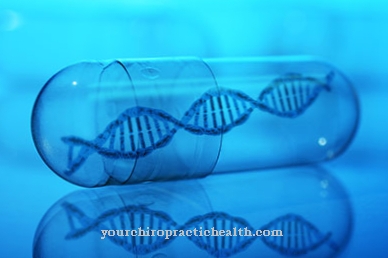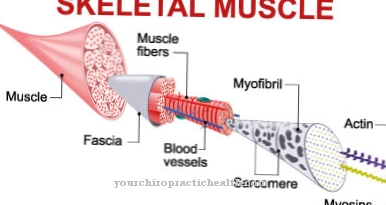The Peanut allergy is a type I food allergy, which means that the symptoms appear immediately after consumption.
What is a peanut allergy?
Peanuts belong to the legume family and are excellent sources of minerals. However, a peanut allergy is one of the most severe food allergies. Even a very small amount can lead to an allergic reaction. Those affected then suffer from dizziness, nausea, reddened skin or a racing heart.
causes
In the case of an allergy, the body's defenses are directed against substances that are normally harmless. Sensitization occurs at the first contact and the immune system forms antibodies against the allergen. Further contact will result in allergic reactions. Ara-h allergens, which bind to IgE antibodies, are the trigger for an allergic reaction. This releases inflammatory mediators.
The antibodies attach to basophilic granulocytes or mast cells. The next time they come into contact with the allergen, the cells release histamine or other substances. Mast cells are found in every body tissue and they are also responsible for the allergic reactions. Basophils are white blood cells.As soon as the allergen gets into the circulation, the granulocytes react, which mainly affects the blood vessels.
A small amount of peanuts is enough for a severe reaction; in some cases, skin contact is enough to cause a rash. Allergies are often genetic. So if one of the parents suffers from a peanut allergy, it is possible that the child can also suffer from it. The risk is even greater if both parents are allergic. Another cause is excessive hygiene, as the immune system is under-challenged and looks for another goal.
Symptoms, ailments & signs

© glisic_albina - stock.adobe.com
A peanut allergy causes symptoms in the digestive system, on the respiratory tract, on the skin or in the cardiovascular system. General symptoms include restlessness, feelings of panic, watery eyes, and swelling of the mucous membrane in the throat or mouth. However, a slowed or accelerated pulse, headaches or clouded consciousness can also occur in connection with a peanut allergy.
This is often noticeable through frequent sneezing, stuffy nose and coughing, asthma attacks and wheezing. It can also lead to nausea, stomach cramps and diarrhea. Redness, wheals or eczema form on the skin; in the worst case, a peanut allergy leads to anaphylactic shock.
Anaphylaxis is life-threatening, so in the event of an anaphylactic shock, the emergency doctor must be informed immediately. To avoid a possible circulatory collapse, it is important to put your feet up until the doctor arrives.
diagnosis
As part of an anamnesis, the doctor first learns about the patient's eating habits, allergies within the family, the psychological state of the person affected or any previous illnesses.
To determine an allergy, the so-called prick test is very often carried out, in which potential allergens are applied to the skin. If allergic reactions appear after about thirty minutes, then there is a potential allergen.
Another diagnostic option is a blood test, which examines the total concentration of antibodies in the blood. These antibodies are responsible for triggering an allergic reaction.
In the provocation test, the doctor gives the test person the allergens intranasally or orally, but very severe reactions can occur here, so this test should never be carried out on your own. In some cases the rub test is also used, in which the allergen is rubbed onto the skin in order to be able to determine any reactions.
Complications
A peanut allergy can have various complications. These occur primarily immediately after the peanuts are eaten and can therefore be identified immediately. The complications are very diverse and can affect the lungs, eyes and digestion. Usually watery eyes, rising panic and swelling in the mouth occur.
Most often these symptoms are accompanied by a headache and dizziness. If a large amount of peanuts has been ingested, the peanut allergy can also lead to shock. In this case, treatment by the doctor is necessary. In the case of mild allergies, the symptoms usually go away on their own. Swelling should also be examined by a doctor.
Due to the peanut allergy, the patient's diet is restricted, so that he is no longer allowed to eat peanuts. However, this only affects a small fraction of the possible foods that are available to the patient. If there is a peanut allergy, treatment can be carried out with the help of medication.
The symptoms disappear completely after a few hours without any further complications. If the peanut allergy occurs for the first time, an explanation from a doctor is necessary. The patient should also test for other allergies and intolerances in order to avoid complications. Above all, this includes other legumes.
When should you go to the doctor?
At the first suspicion of a peanut allergy, those affected should consult a doctor, preferably an allergist, because in some people even small amounts of peanuts are enough to trigger severe allergic reactions such as anaphylactic shock.
Since peanut parts are also contained in many products where they would not be suspected at first glance, it is important that these people are informed about the allergy and its risks by the doctor and that they are given an emergency kit with an antihistamine, cortisone and adrenaline Always have them with you so that you can react quickly in an emergency.
Since some people react to different allergens, a skin prick test is carried out, possibly also a blood test, as a combination of allergies increases the risk of possible complications. At the doctor's, those affected are also fully informed about foods that contain peanuts or traces of them, and they usually also receive nutritional advice from trained specialists, as the treatment of a peanut allergy largely consists of avoiding the allergen in everyday life, and others Informing people about the allergy in situations that may encourage an allergic reaction. The doctor also informs the relatives what to do in an emergency.
Doctors & therapists in your area
Treatment & Therapy
An allergy to peanuts cannot be cured, but there are a variety of measures to be able to live with this disease. In principle, it is necessary to refrain from using peanuts or products that contain them. This is not always easy because many foods and cosmetics contain traces of it. Particular caution is also required with adhesives, bath oils, soaps, vitamin supplements or linoleum.
In medical treatment, those affected also receive glucocorticoids and antihistamines. Nutritional therapy from an appropriate specialist is also recommended. It is important that those affected or their relatives are well informed so that the first symptoms can be recognized quickly. Peanuts are legumes. Some peanut allergy sufferers are therefore allergic to beans or soy or to tree nuts such as pistachios, almonds or hazelnuts.
Outlook & forecast
Like most allergies, peanut allergy is incurable. As with almost all food allergies, "allergy vaccination" is also not an option. Desensitization does not improve the peanut allergy. The patient will therefore be allergic to peanuts for a lifetime and must exercise caution, because the peanut allergens are among the substances that can cause particularly severe symptoms and even dangerous anaphylactic shock with fatal consequences.
However, it is possible that the peanut allergy changes in the course of life - the person affected usually reacts even more violently to contact with peanuts than before. The peanut allergy is often very severe anyway, so that those affected can expect severe symptoms when they eat peanuts. If you do not have an Epi-Pen with you and come into contact with peanuts, severe reactions can result in the patient's death if no one can help him in time.
Furthermore, cross allergies can develop in the course of life, which occur together with the peanut allergy - this does not have to happen, but it is also not possible to determine the time in advance or to name factors that favor the development of cross allergies. It is all the more important that those affected know the most common cross allergies in connection with their peanut allergy so that they would recognize symptoms quickly.
prevention
An allergic reaction to peanuts can be prevented by avoiding products that contain peanuts. These include, for example, cornflakes, savory biscuits, muesli, chocolate bars or fried products. Cold-pressed oils can also contain peanut residues. Refined oils are usually well tolerated and pumpkin seeds are a very good alternative for people with a peanut allergy.
Since 2005, foods containing peanuts have had to be labeled accordingly. Therefore, those affected should read the fine print on the packaging carefully, and it is also advisable to always have an emergency kit with you, in which syringes containing cortisone, adrenaline and an antihistamine can be found.
Loose goods from the bakery are, however, exempt from this allergen labeling regulation, so that one is dependent on the information of the seller. Organic products should be preferred as they contain fewer additives. You can also find your own shops on the Internet that offer products for peanut allergy sufferers.
Aftercare
Often a peanut allergy is diagnosed in childhood. Otherwise, this diagnosis is made through anaphylactic shock after eating a peanut. Since peanuts pose an acute risk to life for a peanut allergy sufferer, prevention is far more important than aftercare.
There are high risks of peanut allergy in children who have numerous skin eczemas and who are also allergic to chicken eggs. Such children may only be given peanut products if they are not already suffering from a peanut allergy.
After an anaphylactic shock from peanuts in childhood, the preventive measures are also follow-up measures. After the acute treatment, the family is advised to strictly avoid food containing peanuts and an emergency kit is provided. This can contain drugs such as antihistamines, Jext-Anapen, Infectodexa Krupp and Salbutamol with a breathing mask. These preparations can save lives in the event of accidental ingestion of products containing peanuts.
Follow-up care mainly consists of caring for the parents and making the social environment aware of this problem. Children cannot take care of themselves yet.
You can do that yourself
Those affected by a peanut allergy have no concrete options for countering the effects of their allergy in everyday life with everyday means. This is limited to carrying an emergency kit and avoiding the allergen. However, it is possible for those affected to convey their own needs to the environment in a targeted manner and to gain added value from avoidance behavior with regard to food.
It is important that those affected communicate in situations in which they could come into contact with the allergen that they absolutely must avoid it. It shouldn't be around. If this encounters a lack of understanding or even resistance, a remedy can be provided by means of a simple explanation (also with the aid of the emergency kit).
Communicating with friends, relatives and possibly the employer makes it easier to move around safely in an environment full of food. Avoiding many products that may contain traces of peanuts also has positive effects. So the person concerned should feel encouraged to try out new foods. By acquiring a broad knowledge of risky and low-risk foods at the same time, he can also decide faster and better what to eat.













.jpg)

.jpg)
.jpg)










.jpg)